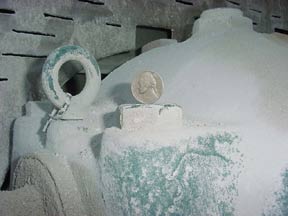As a major manufacturer and distributor of uncoated free-sheet papers, containerboard and corrugated containers, newsprint and market pulp, Boise Paper Solutions provides products that aid their customers in making their own products. That is why having to go offline for unscheduled lime kiln shut-downs at a cost of about $87,000 a year in lost production, makeup time and maintenance costs is disastrous.
 |
| LORD Corp.’s balancing technology allows for a nickel to be balanced on the edge of a fan bearing while in operation. |
Ron Blood, predictive maintenance and reliability supervisor for Boise’s plant in Wallula, Washington, became aware of a continual build-up problem with calcium carbonate on one of their large induction (ID) fans for a lime kiln. According to Blood, particulate had a tendency to stick to the fan rotor and this continuous, nonuniform build-up would throw the fan out of balance. The vibration resulted in an average of 2.5 unscheduled shutdowns per year—at a cost of $33,000 to $35,000 each in lost production, makeup lime and maintenance costs.
…
Add new comment